Net-Zero Hero: Olaniyi 'Akirash' Akindiya
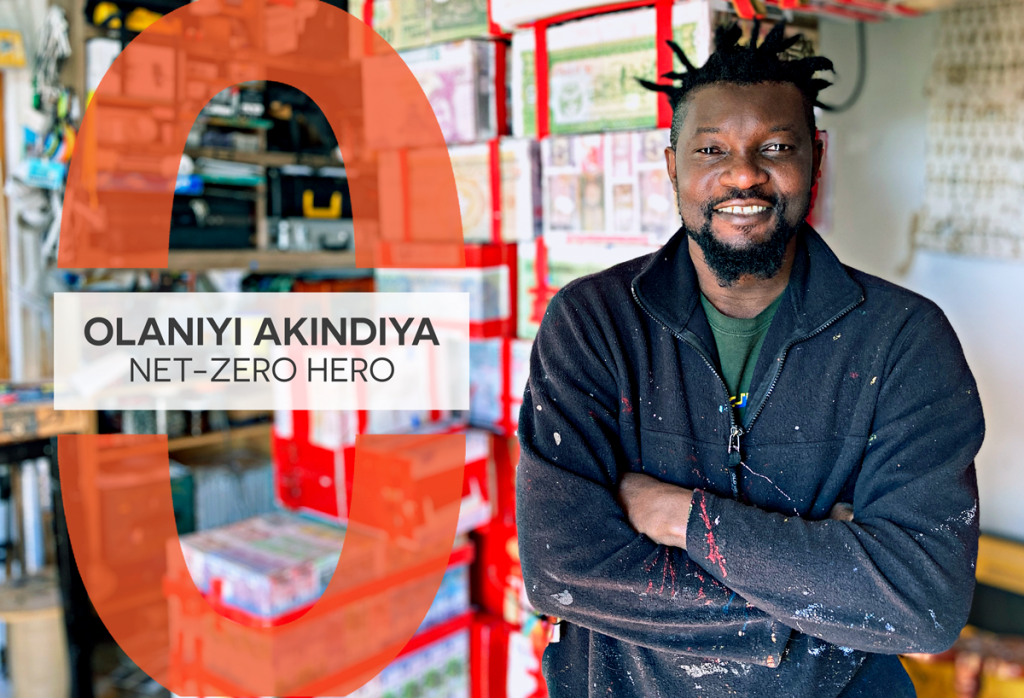
I’m helping to make Austin Net-Zero by incorporating vintage and repurposed materials in my works of art.
Meet Olaniyi Rasheed Akindiya, the artist and changemaker known as Akirash and our newest Net-Zero Hero! Originally from Lagos, Nigeria, Olaniyi’s work has been shown around the world — in Capetown, Yangon, Toronto, and our very own Austin.
An important part of Olaniyi’s mission as an artist is to use upcycled materials in his pieces. From shipping packages to old furniture, Olaniyi breathes new life into the forgotten or discarded items that surround us every day.
We met with Olaniyi at his studio in Pflugerville to learn more about his process, the stories he hopes to tell through his art, and what excites him about using repurposed materials.
What inspired you to take action?
I was born in a society that had nothing. The environment was often forgotten. Our government only remembered these areas when they needed votes. They would make countless promises and, after the election, everything would remain the same.
A few other kids and I decided to take action. We chose particular streets, painted the walls, and created benches to sit. We found pen pals abroad, and we would ask them to send us magazines, books, and VHS tapes — anything we could use to educate ourselves about the world we didn’t know.
We started to have interests in subjects like health, art, history, engineering, architecture, and sports. We incorporated these ideas into the streets we worked on. We debated one another street to street. Since my family didn’t have money, I used anything I laid my hands on to create artwork and beautify my area. We were always improvising.
As I got older, I was interested in becoming a bio-pharmacist. I was tired of how many people I knew who were sick or dying, and I didn’t see anything being done about it. I got my first degree and worked as a pharmacist for two years, but I returned to school to study Fine & Applied Art. I spent all my savings paying for school and art supplies. An important lesson I learned was that hunger could be a change for good or bad. For me, when my hunger was exposed, it inspired me to create. Art became an opportunity to make money to solve my hunger.


Top Left: Olaniyi’s backyard chickens in a coop. Top Right: Olaniyi points out features of his garden and studio space. Bottom: Olaniyi works on a new piece inspired by Winter Storm Uri.
How did you do it?
The wake-up call for me as an artist was to start developing my own paints, creating my own brushes, and introducing repurposed or vintage materials into my work.
My work focuses on time — fleeting moments that can be easily forgotten or transformed. It is a reflection on rural versus urban life, the accelerated pace of development and infrastructure. My performance art centers around themes of trauma and social subjectivities like identity, immigration, gun violence, race, history, and religion. Through all my work, I try to break down conventional barriers.
In exploring the invisible systems of power that govern our everyday existence, I use a lot of different techniques and materials. An important part of all of this is using repurposed objects. I incorporate these objects into mixed media paintings, sculptures, installations, video, photography, sound, and performance art. These objects become part of my overall composition and speak to the complexity of our past and present.
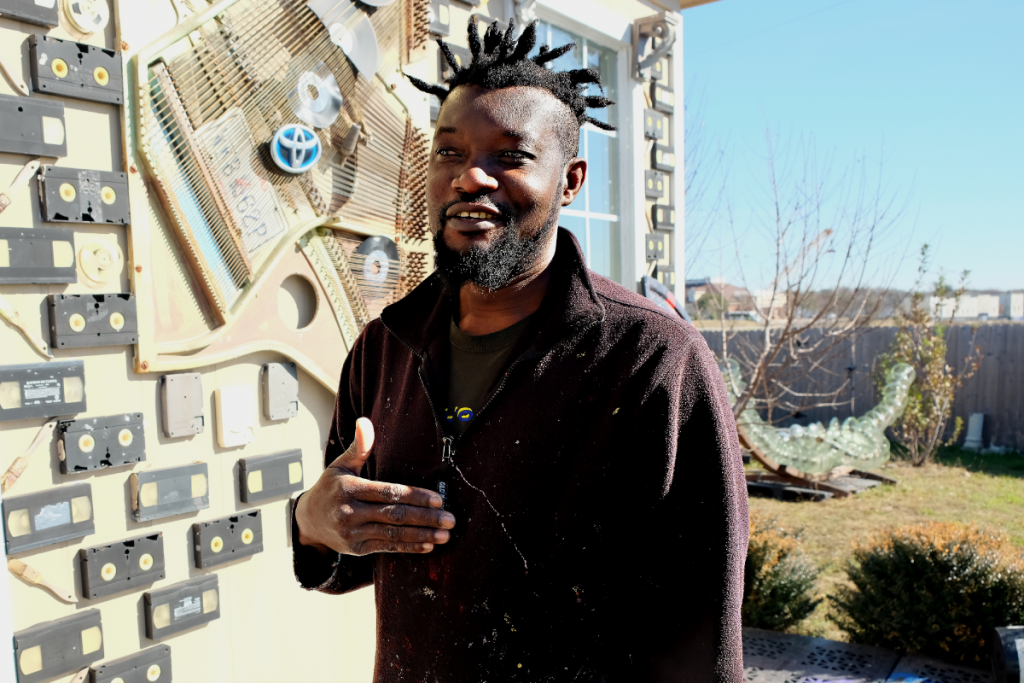
When I choose my subjects, titles, themes, and issues to work on, I always enjoy the process. While my works can be complicated to make, through the use of repurposed materials, I enjoy bringing the past into the present. I think everything that is happening now has happened before, or similar forgotten occurrences have happened. I want my works to educate kids and adults, create dialogues between them, start conversations, and invite them to practice reasoning and common sense.
The use of old things and vintage materials allows us to quickly connect to the works on view. Seeing these items in new ways makes us pause. It gives us a reason to spend more time with the artwork. The items bring up a memory. A conversation can start from there.
What’s been most rewarding about getting involved in this way?
Being sustainable in this way encourages me to read more about the specific history of the repurposed materials I choose to use. I learn how to make them durable, safe, and sustainable in my art and for whoever may decide to acquire them.
It’s rewarding to see reactions on the faces of viewers when they notice these materials, how they are used, what they’ve turned out to be, and how they blend in with the other new materials they are incorporated into.
This has given me exposure to the world — I’ve met people I’ve never dreamt of meeting or talking to. I get to travel the world just to present my works while making money to sustain myself and the people around me. Most of all, it’s rewarding to give back to communities wherever I find myself with the power of my art.
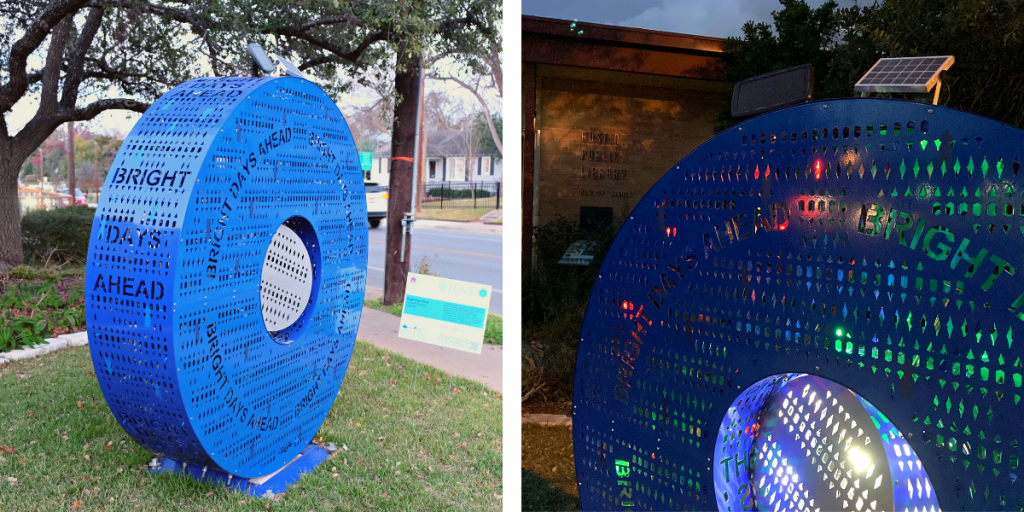
Above: Two photos of Olaniyi's sculpture BRIGHT DAYS AHEAD, on view at the Howson Branch Library. The night-time lights (right) are solar-powered.
What’s been the toughest part?
The toughest part is debating with myself in my studio on how to use the repurposed materials. For each piece, I ask myself how to incorporate the materials in the best way possible for people to understand the message that I am trying to convey in my work. I’m curious about what questions my art may bring up as people see it.
Another tough part is making sure the repurposed materials I plan to use are safe, clean, durable, and sustainable as I put them together.
What was your inspiration for using found and repurposed items in your art? As an artist, how do you connect to the climate crisis?
My work is about today, yesterday, and the future.
Repurposed items are our past and our history. Someone somewhere bought those items as new, used them, and decided one day that they were not good anymore or were damaged. Often, the items are not damaged, but we decide to retire them because we live in the time of fashion — every day of our lives, new things come. We want to be current, so we go with the latest fashions.
To me, repurposed materials have a story to tell us. They remind us of what happened during the moments when those items were still shining. They show us what we saved and remind us how happy we were when we were able to have them. It is a reminder that will bring a spark to an adult's face. Seeing these items again brings back memories that we want to share, especially if we have our children around us.
For youth, seeing the repurposed items that I use is like sending them back to school or into the library. They start asking questions. They have the chance to understand what the world looked like before today, before the invention of the first cell phone, for example.
The climate crisis is a big problem. We all are responsible, and many of us still don’t get it. Almost everything we use is manufactured with many polluting substances. We use them until they may become damaged beyond repair, or we retire them because there is a newer version out and we want to be current. All this contributes to the climate disaster. As an artist, my works move beyond beauty. They remind us, create opportunities to start a conversation, and serve as a wake-up call on the climate crisis — while also giving us a chance to enjoy the creativity of art.
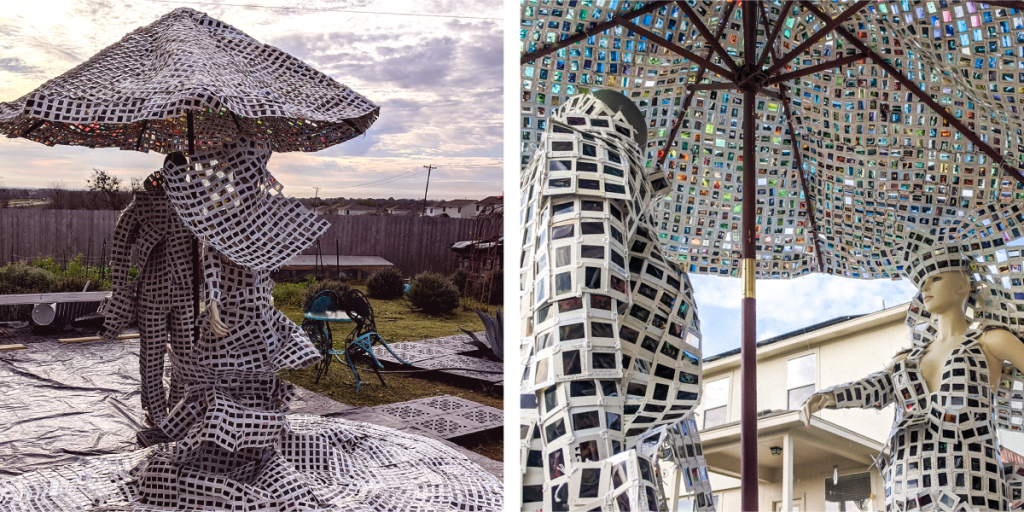
Above: Photos of a sculpture by Olaniyi that was created from old photo slides.
What advice do you have for others?
In every situation we find ourselves in, we need to just pause for a second and look at ourselves from head to toes. We need to look around ourselves as we walk or drive. Then we can start to know that everyone feels what we are feeling at different levels to one another.
We need to do better and have to stop waiting for the government to solve every problem. We need to start with our family, our street, our community, our county, and so on. Start with a little contribution — it will reduce the problem of the climate crisis. We all have to come together to solve this with all the small powers we have.
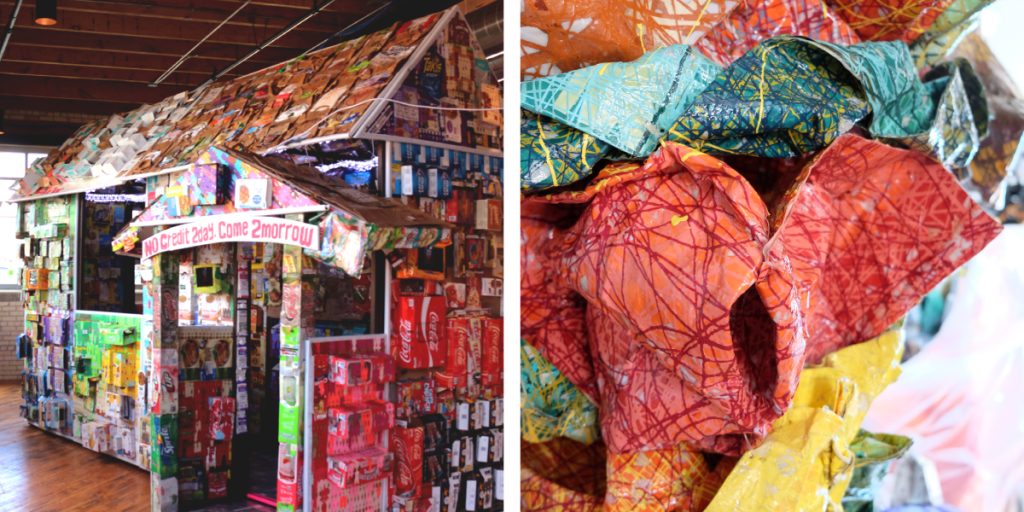
Left: An installation by Olaniyi’s titled “Ile Itaja - Shopping List #2”. Right: A work in progress made from manipulating and painting paper.
Is there a book, documentary, or other piece of media you would recommend for those interested in learning more about these topics? What inspires you about this, or why did you choose to share it?
What I will say is that we don’t need a book or documentary — we should look at what we put in our trash bin every week. Do we ever ask ourselves where it is going? Or what happened to it? Or how can we reduce it from our own homes? This is an example of the wake-up call we need.
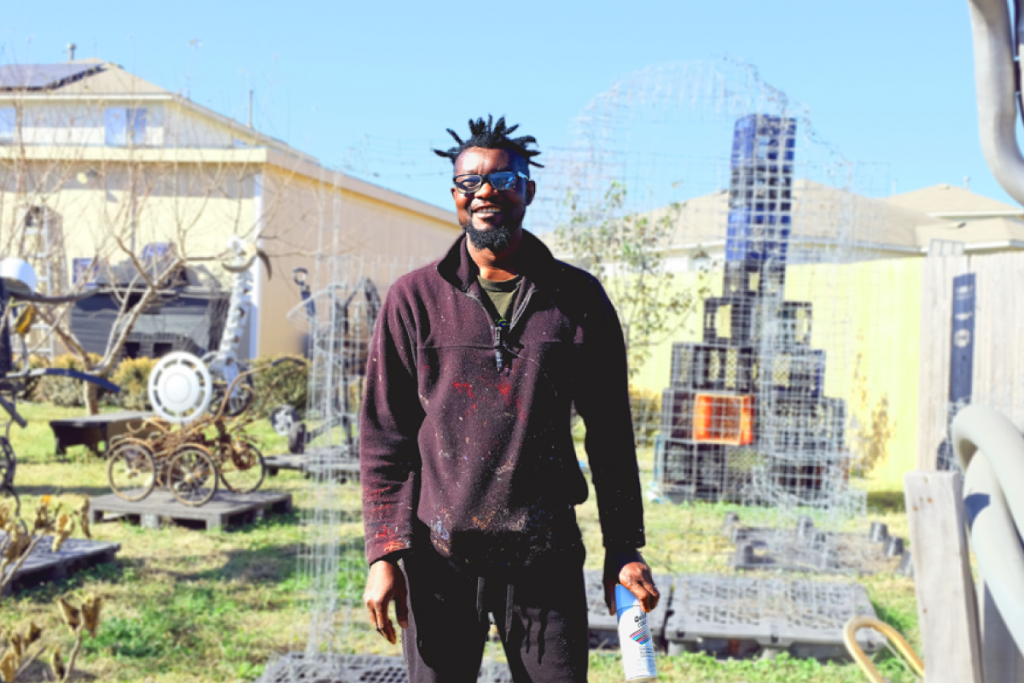
Olaniyi’s artwork BRIGHT DAYS AHEAD, which incorporates solar-powered elements, can be seen at the Howson Branch Library as part of Art in Public Places’ 2021 TEMPO Program. Visit Olaniyi’s website to view more of his artwork and learn more about his process.
To learn more about Austin's net-zero goal and explore actions you can take to support a greener community, view the Austin Climate Equity Plan.
Share your Net-Zero contributions with us on X (formerly Twitter) or Facebook, and use #NetZeroHero. If you know a Net-Zero Hero (or heroes!) who should be recognized for their efforts, send your nomination to climate@austintexas.gov.

